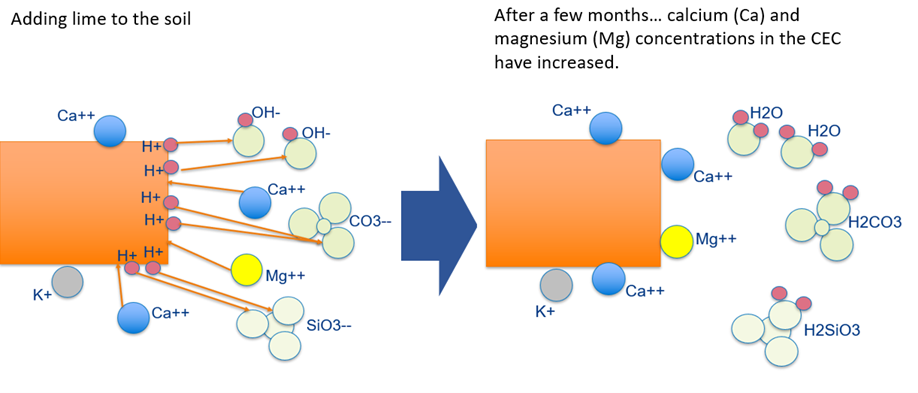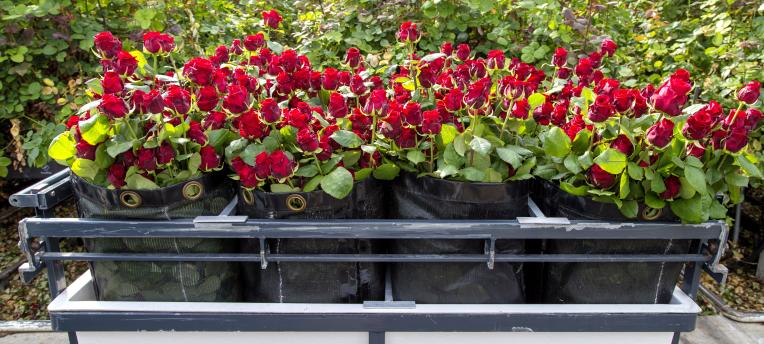A beautiful rose for Valentine’s day starts with the soil
2 October 2024 - News
Good soil condition is essential for healthy crops, and healthy crops are vital for strong production. As you prepare for Valentine's Day, now is the perfect time to focus on your soil health. This begins with soil testing. But what exactly does 'good' soil condition mean?
Your roses will have a healthy root system when they grow in a well fertilized soil with a good soil structure. Lime application in both sandy and clayish soil types will increase Ca-soil stock and Mg-soil stock, % calcium carbonate, CEC capacity and will improve the soil structure. The figure below shows the chemical reaction in the soil extract after adding lime fertilizers to the soil; cations Ca2+, K+, H+ bound to clay minerals (= CEC).

Figure 1. The chemical reaction in the soil extract after adding lime fertilizers to the soil
A healthy root system is very important when your roses are cultivated in the soil for several years. Calcium for example is only taken up by hair roots and root tips; sufficient calcium uptake is necessary for strong cell walls/membranes and growth speed. Calcium deficiency will cause growth inhibition and necrosis of growing points, so less production.
A moderate and stable pH in the soil extract is very important for your roses; the roots grow smoothly and new roots develop. A moderate pH in the root environment will improve the solubility of micronutrients. Copper for example is a very important micronutrient for rose bud quality. Copper deficiency can cause disrupted rose bud development. At moderate and stable pH the plant can take up sufficient copper week after week; that is important because micronutrients - like copper - cannot be redistributed in the plant easily.
It is important to note that in sandy soils pH values can be 1 to 3 pH points lower than clay soils. Also in source water with clay soils, we have measured more bicarbonate and thus higher pH values. Therefore, it is important to adjust your irrigation practices as the more irrigation is applied the more the pH values (drip and soil) are alike. You can manage to control pH in the root environment by adding ammonium fertilizers in your fertilizer recipe. But please note that ammonium in the soil moist is not improving soil life (mycorrhiza and earth worms, among others).
Rose production planning via plant nutrition
Production planning starts with an optimal growth. Optimal growth is influenced by several factors, plant nutrition is one of them. Several nutrients directly influence growth speed.
- Calcium: development of growing points (leaves, rose buds).
- Nitrogen: protein synthesis (all aminoacids contain nitrogen), leaf size, chlorophyll.
- Sulphur: part of proteins, cell membranes, suppressing heavy metal effects.
- Potassium: regulation of opening/closing of stomata, transport of assimilates.
- Magnesium: protein synthesis, chlorophyll.
- Micronutrients: involved in several protein syntheses (cell elongation, photosynthesis…).
When you collect soil samples for Eurofins nutrient test codes 210 and 215, you get the required test results to optimise your production.
With these soil test results you can decide to adjust the fertilizer plan in October/November. The effect of the adjustment must have their effect in the months before Valentine’s Day:
- Any effect from lime application in November is visible in the crop in January.
- Any effect from “slow release” fertilizers is visible in the crop in January.
- Any effect from solid, not in water soluble fertilizers is visible in the crop after 1-2 weeks.
- The effect of solid in water soluble fertilizers via drip irrigation is a few days.
- The effect of pH control in the soil via ammonium containing fertilizers is 1-2 weeks.
- The effect of acids in your day storage tank/water reservoir is approximately 8 hours.
So don’t wait to prepare your sending and get ready for Valentine’s with Eurofins.
For questions, please contact your local dealer or our customer support team.






